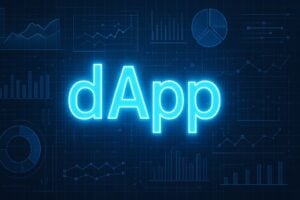In the second quarter of 2025, the DApp reached new milestones in terms of adoption and innovation in the field of decentralized finance, NFTs, and public blockchains.
The growing involvement of users and developers reflects the concreteness and the potential now recognized globally.
Significant Increase in DApps: Numbers and Trends
The DappRadar report shows how the second quarter saw a remarkable expansion in the number of active DApps, reflecting a constant interest from both the user community and developers worldwide. This phenomenon has resulted in a strengthening of the sector’s market capitalization, reaching new historical heights. Consequently, decentralized applications are establishing themselves as indispensable tools in various sectors of the new digital economy.
DeFi: solidity and reliability at the heart of DApps
The DeFi sector has confirmed itself as a protagonist, leading growth through innovative and decentralized financial services. Reliability and security have remained at the center of attention. With increasingly transparent systems, many DeFi applications have improved market share and user trust. The platforms have distinguished themselves by their ability to offer real alternatives to traditional banking solutions, promoting broader financial inclusion.
Main advantages of DeFi applications
- Automation of payments and loans through smart contracts
- Open access without banking intermediaries
- Transparency in operations and conditions
- Security strengthened by decentralized mechanisms
NFT: expansion beyond digital art
During the quarter, the boom of NFTs consolidated. However, the most significant novelty was their diversification of use. In addition to representing digital artworks, NFTs began to intertwine with sectors such as gaming, certificates of authenticity, and management of unique digital assets. This versatility has had a disruptive impact, expanding the reach of DApps and attracting new categories of users and investors.
Public blockchains and technological evolution
Public blockchain have been the focus of the most interesting technological advancements in the examined period. Network updates and the introduction of more scalable systems have allowed DApps to gain more speed and reliability. The scalability resolved through Layer-2 solutions, for example, has made it possible to handle higher transaction volumes without negatively impacting costs or processing times. The usability of applications has also improved, encouraging adoption by those approaching the decentralized world for the first time.
Key Innovations in DApp Infrastructure
- Security improvements at the level of smart contracts and blockchain infrastructures
- More engaging user interfaces and simple to use
- Support for asset finanziari such as Bitcoin and next-generation digital currencies
- Integration of cross-chain services for interoperability between blockchains
Expansion, regulation, and future scenarios for DApp
Looking ahead to the second half of the year, the DApp industry is preparing for new challenges. Further expansion of the ecosystem is expected, driven by the entry of traditional companies interested in leveraging the potential offered by decentralized applications. However, regulation remains a crucial variable: authorities and the community are working to define common standards that ensure security and transparency without hindering innovation.
Factors to monitor in the upcoming period
- The evolution of international normative on crypto and decentralized finance
- Developments on the security and user protection front
- The reaction of traditional markets and the integration with legacy systems
DApp as the engine of global digital transformation
The second quarter of 2025 marks a crucial phase in which DApp establishes itself as a driver of digital transformation on a global level. The increase in market value and the ongoing momentum in innovations suggest that the sector will maintain a central role in the digital economy.
Exploring and adopting these technologies can offer new opportunities to both private users and companies seeking advanced solutions. In this context, monitoring regulatory progress, security, and the evolution of infrastructures will be essential to fully grasp the advantages offered by decentralized applications.









